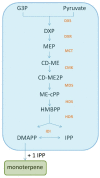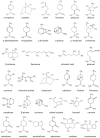Toxicity of Selected Monoterpenes and Essential Oils Rich in These Compounds
- PMID: 35268817
- PMCID: PMC8912113
- DOI: 10.3390/molecules27051716
Toxicity of Selected Monoterpenes and Essential Oils Rich in These Compounds
Abstract
Monoterpenes make up the largest group of plant secondary metabolites. They can be found in numerous plants, among others, the Lamiaceae family. The compounds demonstrate antioxidative, antibacterial, sedative and anti-inflammatory activity, hence, they are often employed in medicine and pharmaceuticals. Additionally, their fragrant character is often made use of, notably in the food and cosmetic industries. Nevertheless, long-lasting studies have revealed their toxic properties. This fact has led to a detailed analysis of the compounds towards their side effects on the human organism. Although most are safe for human food and medical applications, there are monoterpene compounds that, in certain amounts or under particular circumstances (e.g., pregnancy), can cause serious disorders. The presented review characterises in vitro and in vivo, the toxic character of selected monoterpenes (α-terpinene, camphor, citral, limonene, pulegone, thujone), as well as that of their original plant sources and their essential oils. The selected monoterpenes reveal various toxic properties among which are embryotoxic, neurotoxic, allergenic and genotoxic. It is also known that the essential oils of popular plants can also reveal toxic characteristics that many people are unaware of.
Keywords: abortifacient; genotoxicity; monoterpenes; neurotoxicity; plant secondary metabolites; teratogenicity; toxicity.
Conflict of interest statement
The authors declare no conflict of interes.
Figures



References
-
- Chen H., Singh H., Bhardwaj N., Bhardwaj S.K., Khatri M., Kim K.-H., Peng W. An exploration on the toxicity mechanisms of phytotoxins and their potential utilities. Crit. Rev. Environ. Sci. Technol. 2020;52:395–435. doi: 10.1080/10643389.2020.1823172. - DOI
-
- Thakur A., Sharma V., Thakur A. PhytotoxinsA mini review. J. Pharmacogn Phytochem. 2018;7:2705–2708.
-
- Khodaei N., Nguyen M.M., Mdimagh A., Bayen S., Karboune S. Compositional diversity and antioxidant properties of essential oils: Predictive models. LWT. 2021;138:8110684. doi: 10.1016/j.lwt.2020.110684. - DOI
Publication types
MeSH terms
Substances
LinkOut - more resources
Full Text Sources

